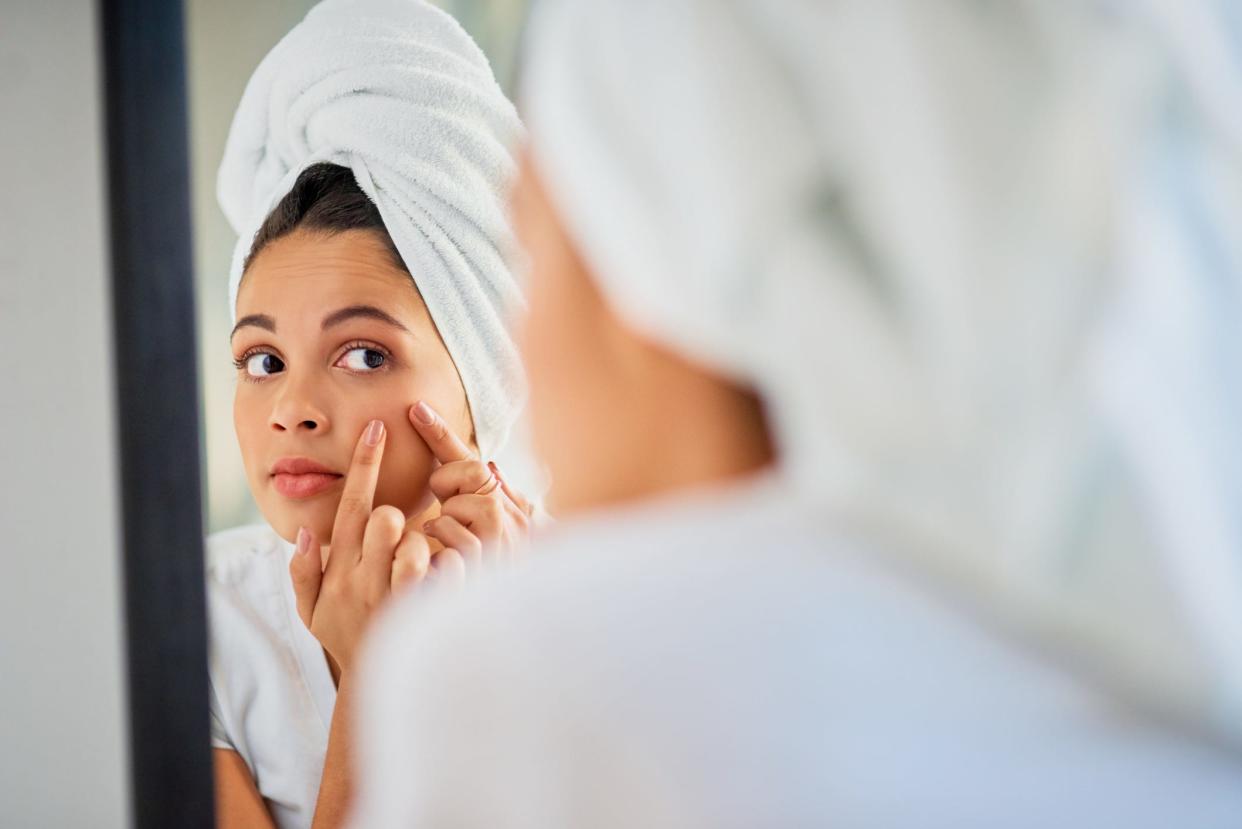This Is How to Get Rid of Blackheads, Once and for All

If you have pores—all of us do!—you've struggled with blackheads at some point in your life.
But what exactly are blackheads, anyway? "Blackheads are basically enlarged pores that are filled with oil and dead skin cells that didn't slough from the surface normally," explains Nancy Samolitis, MD, FAAD, owner and cofounder of Facile Dermatology + Boutique.
They're not the same as clogged pores, whiteheads, or acne, though. Blackheads, also known as open comedones, differ from closed comedones, which "are clogged pores that are not open on the surface, so they look more like small white bumps," Samolitis says.
And though blackheads are, well, black like dirt, it's not dirt. "While many people think that the black color is due to dirt, it is actually a result of the clog getting oxidized by the air," says Brian Ginsberg, MD, board-certified dermatologist at Chelsea Skin & Laser and clinical assistant professor of dermatology at Mount Sinai Hospital.
If you've been battling blackheads since you were young: congratulations. You may have your genes to blame. "Some people are just genetically prone to having larger pores or increased oil production, and both of these are contributing factors for blackheads to form," says Samolitis. "As we age and the skin loses its elasticity, pores can also enlarge and develop blackheads. This can occur on the face or anywhere on the body." So, if you get blackheads on your face but wondered if those dark spots on your chest, back, or neck were blackheads, too, they just might be.
What's the best way to get rid of blackheads at home?
"The most effective approach is to fix any underlying issues that are causing blackheads, like dead skin and oil," explains Morgan Rabach, MD, board-certified dermatologist and cofounder of LM Medical in New York. "Using active ingredients that decrease oil production, slough away dead skin cells, and regulate the growth of dead skin cells is the best method. The best ingredient for the job is retinol."
Rabach also recommends other exfoliating methods, whether physical or chemical. And, of course, there are extractions, which work well but need to be part of a larger strategy. "Squeezing blackheads out is satisfying, but it doesn’t change the reason behind their formation, so they will keep coming back if extractions are the only method you use."
To instantly remove blackheads from your face, grab some Q-Tips...
When it comes to blackheads, the process is generally similar regardless of what area of the face you're treating. "The quick and easy way to remove them is to perform an extraction," explains Samolitis. "Since the pore is already open, you don't need to use a needle or tool to pierce the skin. Gentle pressure can be applied around the blackhead to squeeze it out. I prefer using two Q-tips to perform the extractions, because they won't damage the skin like squeezing with fingernails or even a comedone extractor can."
However, adds Samolitis, you can remove them more slowly through exfoliants or peels. "The slower way to remove and prevent them is to use an exfoliant or peel containing salicylic acid to dissolve the oil and dead skin cells and a retinol to normalize skin cell turnover, which prevents clogging in the first place."
And to get rid of blackheads on your body, try this...
"The skin on your body is thicker than the skin on your face, so you can use a higher percentage of active ingredients like retinols, salicylic acids, and alpha and beta hydroxy acids to remove blackheads on the body," says Rabach. Luckily, on the back or chest, you can get away with frequent exfoliation and higher-strength chemical peels on the body that might otherwise be too irritating to the face.
If products aren't cutting it, other options are available. Adds Samolitis: "Some blackheads on the back and body can be much larger, causing the pore to be irreversibly damaged. Even when the contents are extracted, the pore will eventually fill back up. The more aggressive approach to removing blackheads on the back and body permanently is to do a small surgical excision."
Do DIY recipes like toothpaste work?
Forget what you've heard about potentially using toothpaste to dry up your blackheads. On this DIY beauty hack, Samolitis is crystal-clear: "Toothpaste doesn't work for blackheads. The only effective remedies are those mentioned above." Start with gentle manual exfoliation and products like peels, exfoliants, or masks, and then progress to surgical excision or a trip to your doctor if the blackheads truly won't go away. Sadly, this is one time when DIY won't cut it.
Will my blackheads ever permanently go away?
If it seems like you're constantly fighting a losing battle against blackheads, it might not just be your imagination. "Because some people are genetically prone to developing blackheads, they can always come back after removal," says Samolitis. "Regular use of salicylic acid and retinol can keep them at bay but won't clear them 100 percent. Oral retinoids like Accutane [usually prescribed for severe, cystic acne] will shrink oil glands permanently and potentially 'cure' blackheads, but that is not recommended for someone with a mild case."
But don't worry, all is not lost. If you're following the proper blackhead-tackling skincare regimen, you can start to see long-term relief. "Blackheads can improve dramatically with retinols, salicylic acid, and regular exfoliation," assures Rabach.
For more stories like this, plus all things Oprah, sign up for our newsletter.
You Might Also Like

